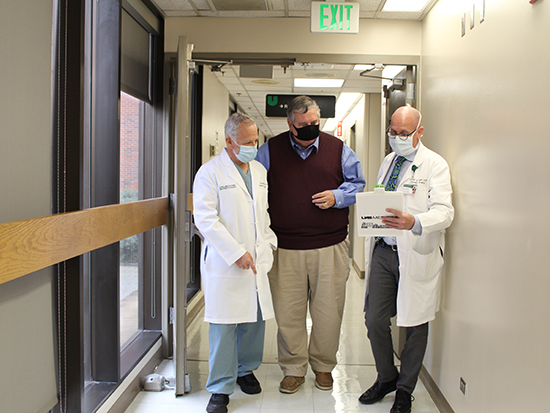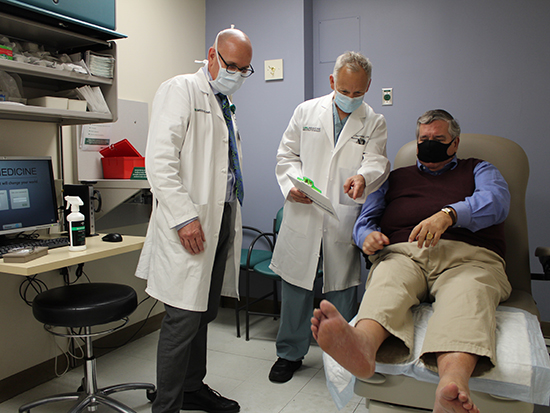Media contact: Anna Jones
 The UAB Advanced Limb Preservation Program represents a multidisciplinary collaboration involving numerous fields of study, including vascular surgery, podiatry and wound care. This team focuses on lower extremity limb preservation, diabetic foot care and complex wound management for patients like Kenneth Mullinax.
The UAB Advanced Limb Preservation Program represents a multidisciplinary collaboration involving numerous fields of study, including vascular surgery, podiatry and wound care. This team focuses on lower extremity limb preservation, diabetic foot care and complex wound management for patients like Kenneth Mullinax.
(Photography: Emma Shepard)Behold the big toe. Called the great toe in medical circles, the big toe is essential in balance, as it displaces body weight throughout the foot. Without a big toe, walking, standing and even moving may be difficult.
So when Alabama State University Director of University Relations Kenneth Mullinax was told that his big toe on his left foot may need to be amputated, he went straight to the University of Alabama at Birmingham to see Brent Haverstock, DPM, podiatry director of UAB Medicine’s Advanced Limb Preservation Program. Mullinax had experience with Haverstock and felt he was the right doctor to treat him again.
A few years earlier, Mullinax experienced an infection in his second toe, or long toe, on his right foot — a complication related to his diabetes. He called the UAB Advanced Limb Preservation Program at Russell Clinic, which scheduled an appointment for Mullinax for the very next day.
At the appointment, Haverstock admitted Mullinax to UAB Hospital, where he received IV antibiotics over the course of three days. Haverstock and Kenneth Unger, DPM, assistant professor in the UAB Division of Vascular Surgery and Endovascular Therapy, oversaw Mullinax’s treatment. Their efforts were successful, the infection cleared, and the long toe was saved.
“Often we see that those with diabetes experience related foot complications, like infected toes in Mr. Mullinax’s case,” Haverstock said. “And while we do have advanced limb preservation techniques at UAB, we encourage those with diabetes to seek preventive treatment for infections, and other complications, of this sort.”
Several months after the long toe infection, Mullinax suffered a second infection — this time in his big toe on his left foot. After being told that his big toe would likely need to be amputated at a local ER, Mullinax put his shoe back on his foot and drove straight to UAB to seek care again from Haverstock and Unger.
 (Photography: Emma Shepard)“I knew after Drs. Haverstock and Unger helped me with my right foot that, when my left foot became infected, I had to come to UAB to let them work their magic again,” Mullinax said. “Being a teaching institution, UAB propels its physicians to stay at the forefront of their field, learning and staying up to date on improving practices and techniques.”
(Photography: Emma Shepard)“I knew after Drs. Haverstock and Unger helped me with my right foot that, when my left foot became infected, I had to come to UAB to let them work their magic again,” Mullinax said. “Being a teaching institution, UAB propels its physicians to stay at the forefront of their field, learning and staying up to date on improving practices and techniques.”
At the appointment, Haverstock admitted Mullinax again and scheduled him for his next available surgery, which was six days away. In the meantime, Mullinax was treated with a round of IV antibiotics and seen by Unger.
When Haverstock performed surgery, he treated Mullinax’s big toe using advanced antibiotic, impregnated, resorbable beads that would be able to fight the infection more acutely. The beads turned out to be a winning strategy against the infection.
“I call them the dynamic duo,” Mullinax said. “When the local ER told me there was nothing they could do to save my big toe, I packed up my things and made the trek to UAB because I knew they would have the most advanced care available. My family has always chosen UAB and will continue to do so.”
Ultimately Haverstock and Unger were successful in preventing amputation for Mullinax, and he is now seeking preventive care related to his diabetes, rather than responding to major, late-stage infections. Mullinax encourages those with diabetes, and all patients, to advocate for themselves and seek second opinions when needed.
“I wish I could communicate to everyone across Alabama and to physicians who treat diabetic issues about these guys and what they offer so they could save people’s toes, legs and even lives,” Mullinax said. “UAB’s Advanced Limb Preservation Program is an incredible resource that is fully equipped to support diabetic complications.”
Learn more about UAB’s Advanced Limb Preservation Program here.
Haverstock says it was an honor to treat Mullinax and continue to play a role in his new prevention strategy.
“Mr. Mullinax is a star example of switching into a preventive form of care for diabetes,” Haverstock said. “I am grateful to practice at a health care institution like UAB with the resources to be able to treat patients who may have been told they have no other choices. We hope patients will continue to look to our Advanced Limb Preservation Clinic for advanced, compassionate care.”
